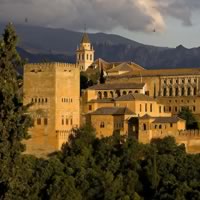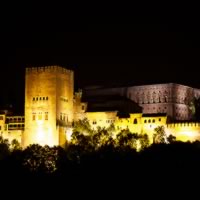Day 1 in Granada
Arrive at the train station in Granada and proceed to your hotel. Should you desire, we offer private transfers where a representative will meet you at the train station and transfer you to your hotel. (Click on Hotel Transportation in the Booking Process.) Check into your hotel and begin your afternoon with a pleasant lunch in any of the street side cafes to be found in Plaza de Bib-Rambla or elsewhere near the cathedral.
Following lunch, head to the Catedral de Granada, built on the sight of the former Great Mosque. Adjacent to the Cathedral, be sure to visit the Capilla Real (Royal Chapel), which houses the tombs of the Catholic Kings. Catholic Monarchs Isabella of Castile and Ferdinand of Aragón are buried at this shrine and the sacristy holds Ferdinand's sword and Isabella's crown and scepter as well as a fine collection of Flemish paintings once owned by Isabella. Then proceed to the Plaza Nueva, the oldest plaza in Granada, and the Iglesia de Santa Ana.
Later take a bus or a taxi to see the most beautiful and historic neighborhoods of Granada, the Albaycin and the Sacromonte. The Albaycin is located on a hill opposite the Alhambra and is where you will find the typical narrow streets lined with old Arab houses. Be sure to see the stunning sunset views of the Alhambra from the Mirador de San Nicolás (St Nicholas Outlook). Then, sip mint tea and dine on authentic falafel and kebabs before heading to the Sacromonte, famous for its gypsy caves, beautiful natural surroundings and traditional flamenco shows. Flamenco shows here start quite late (11:00pm or after). Earlier shows can be found in the center.


Day 2 in Granada
Start your day like a local with sugary churros (doughnuts) dunked in hot chocolate. Today we recommend that you purchase our optional tour 'Skip the Line: Alhambra and Generalife Gardens Half-Day Tour' that will allow you to see the intricately embellished halls and patios of this imposing 13th century fortress palace of the Nasrid kings as well as the lush cypress tree-studded gardens of the Generalife. As the most visited monument in Spain and with a predetermined quota of tickets sold daily - you do NOT want to miss out!
This afternoon, you may want to relax with a soak and massage at Los Baños Arabes (Arab baths) or explore the historic center in more depth. Enjoy a leisurely lunch and shopping along Gran Vía de Colón or Calle de los Reyes Católicos.
This evening, experience el tapeo (tapas walk) while strolling along Granada's most romantic street, the Carrera del Darro, running north along the Darro River. Carrera del Darro ends at Paseo de los Tristes (Avenue of the Sad Ones), named for the funeral corteges that used to go by en route to the cemetery. This is a great place for drinks and stunning views of the Alhambra.


Day 3 in Granada
Lovers of literature may want to visit the Casa de Federico García Lorca. The poet and dramatist spent many happy summers here with his family at their vacation home. You can see the Alhambra from one of its balconies; look for the white stool that he carried to the terrace to watch the sun set over Granada. You can also visit the poet's upstairs bedroom and see his oak desk stained with ink. The house is in the Fuentevaqueros section of Granada, near the airport.
Also worth seeing is the Monasterio de San Jerónimo, which was founded in the 16th century by the great Catholic monarchs Ferdinand and Isabel. Built by Diego de Siloé, the main attraction of the monastery is the sacristy, which is heavily ornamented and gilded. All the stones used for its construction were taken from the Arab gate of Elvira. Gonzalo Fernández de Córdoba, known as the Gran Capitán (Great Captain), is buried here along with his wife, Doña Maria de Manrique.
Next stop is the Monasterio de la Cartuja, one of the finest examples of Spanish Baroque architecture, which also features great paintings and sculptures of the Granada School. Formerly a Roman cemetery, it was founded in 1506. While the exterior is rather plain, the interior is a dazzling display of marble, ornate carvings and gilt! The most striking features include the tabernacle, designed by Francisco Hurtado Izquierdo, and the famous sacristy, built between 1727 and 1764 by Luis de Arévalo and F. Manuel Vasquez. Despite the grandeur of their surroundings, the Carthusian monks lived a humble life here. (You can still buy rosary beads made from rose petals in the souvenir shop).


Additional Days in Granada
Lovers of literature may want to visit the Casa de Federico García Lorca. The poet and dramatist spent many happy summers here with his family at their vacation home. You can see the Alhambra from one of its balconies; look for the white stool that he carried to the terrace to watch the sun set over Granada. You can also visit the poet's upstairs bedroom and see his oak desk stained with ink. The house is in the Fuentevaqueros section of Granada, near the airport.
The rugged peaks of the Sierra Nevada attract hikers, mountain bikers and wildlife enthusiasts. Skiers race downhill on Solynieve's sunny slopes in winter, while climbers ascend the highest peak, Mulhacén (11,410 feet), for glimpses of North Africa in summer. Others seeking a taste of rural Andalusia head off into the lush wooded valleys, gorges and white villages of Las Alpujarras.


Your Last Day in Granada
Depart your hotel for the airport for your return home. We recommend that you purchase a private transfer, if so a representative will meet you at the hotel, in time to take you to the airport for your flight out.
